What Is a Democracy?
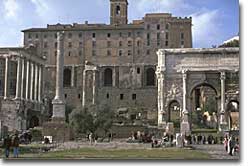
The ancient Romans had a working democracy for the early part of their history. The Forum in Rome is where political meetings and votes were held. The Forum can still be seen today, but most of its buildings are in ruins.
Nowhere is the word “democracy” mentioned in the Declaration of Independence or the U.S. Constitution. How could that be? Our government is a democracy!
Well, for one thing, the Founders actually feared democratic rule. James Madison expressed this attitude in Federalist Number 10:
. . . instability, injustice, and confusion . . . have in truth been the mortal disease under which popular governments everywhere perished . . .
In the late eighteenth century, rule by the people was thought to lead to disorder and disruption. Yet a democratically based government was seen as superior to the monarchies of Europe.
Democracies did not originate with the founding of the United States. The term democracy comes from two Greek words: demos (the people) and kratia (power or authority). So a democracy is a form of government that gives power to the people. But how, when, and to which people? The answer to those questions changes through history.

In present-day New England, many small towns hold town meetings in which issues important to the citizens are decided by vote. These meetings are one of the few instances of direct democracy that still occur today. These New Englanders check in at a town meeting.
Democracies are based on “rule of law.” The Ancient Greeks (particularly Aristotle) valued natural law, the notion that human societies should be governed by ethical principles found in nature. The Greeks are famous for practicing direct democracy, a system in which citizens meet to discuss all policy and then make decisions by majority rule. However, in Ancient Greece, only free males were considered to be citizens. So their democracy was certainly limited. Today direct democracy is practiced Through initiative, referendum and recall elections. In the initiative process citizens write a bill and then vote on whether or not to adopt it. The referendum process is a bit different; the legislature writes the bill and then submits it to the citizens for the approval. A recall is a special election called for by citizens to remove an elected official from office.
Ballot Measures
Many states offer people the opportunity to vote on ballot measures on proposed laws, ordinances, or constitutional amendments. Two types of ballot measures are the initiative and the referendum. In the 2010 midterm election, a total of 160 questions were considered on ballots in 37 states. Another type of ballot measure is the recall election, whereby voters can remove an elected official from office.
The Referendum
In a referendum, the state legislature refers a proposal to citizens who vote to either approve or reject the measure. In every state except Delaware, amendments to the state’s constitution passed by the legislature go on the ballot automatically.[1] State legislatures put other measures on the ballot to let voters make a choice or to avoid deciding a controversial issue. Referenda also can work as an end run around decisions made by a state governor.
The Initiative
The initiative is similar to the referendum except that voters propose and pass laws and present them to the state legislature. Citizens also can propose an amendment to the state constitution. In some states, the legislature can adopt the proposal outright. In most cases, registered voters can place a proposal on the ballot, sometimes with a counterproposal from the state legislature. If the initiative wins a majority of the votes in an election, it goes into effect.
In recent years, initiatives have been passed to cap property taxes, curtail illegal immigration, and allow medicinal marijuana and euthanasia. California had sixteen initiatives on the ballot in 2004, including a proposal to spend $3 billion for research on human embryonic stem cells, which passed with 59 percent of the vote. In six states, citizens’ groups put on the ballot for a vote to an amendment to the state constitution that recognized marriage as between one man and one woman. In 2010, initiatives related to fiscal policy and taxes were most prevalent. The proposals differed vastly from lowering property taxes in Indiana to overturning a tax on soda in Washington.[2]
Link: State Ballot Measures in the 2010 Elections
Voters in states considered over 160 ballot initiatives in the 2010 midterm elections, which are described on Stateline’s website.
The initiative was originally designed to combat powerful interests such as those controlling the railroads in the nineteenth century.[3] Today, initiatives are sometimes a way for wealthy individuals or interest groups to put policies into effect while bypassing the state legislature. Consulting firms specializing in initiative campaigns are paid to collect the signatures required to put a measure on the ballot.[4]
Critics attack initiatives for congesting ballots and confusing voters, and for their sometimes deceptive titles and descriptions. “Keep California Green” was the slogan for a proposition to keep taxes low on private golf courses. However, research shows that “the initiative has a significant impact on state and local government and in doing so pushes policy in the direction a majority of people say they want to go.”[5]
The Recall
Originally intended to root out corruption among elected officials, the recall allows voters to remove public officials from office through a direct election. A recall is initiated when a designated number of voters sign a petition requesting a special election. Fourteen state constitutions provide for recall elections for state officials, and many localities have provisions for the recall of lower-level elected officials.

Movie action hero Arnold Schwarzenegger is elected governor of California in the recall election of 2003. This is a stellar example of how prominence in the entertainment media can be translated into visibility in the news media and victory in politics.
Until 2003, only one governor, North Dakota’s Lynn J. Frazier in 1921, had been successfully recalled. In 2003, a California Republican congressmen initiated and mainly funded the recall of California’s Democratic governor Gray Davis for his alleged policy failings. Spurred by conservative talk-radio hosts, websites run by Republican operatives, disenchanted Democrats, and antitax organizations, and coordinated by e-mail, more than 900,000 eligible voters signed the petition to put the recall on the ballot. The ballot asked voters two questions: if the governor should be removed from office and who they would select from a list of candidates to replace him if the governor were recalled. The voters selected Republican Arnold Schwarzenegger to replace Governor Davis.
But how could direct democracy work in a large, diverse population spread over a geographical distance? Generally, the answer has been that it can’t. In its place, the American Founders put “indirect” or “representative” democracy. In this system, representatives are chosen by the people to make decisions for them. The representative body, then, becomes a manageable size for doing the business of government. The Founders preferred the term republic to democracy because it described a system they generally preferred: the interests of the peopled were represented by more knowledgeable or wealthier citizens who were responsible to those that elected them. Today we tend to use the terms republic and democracy interchangeably. A widespread criticism of representative democracy is that the representatives become the “elites” who seldom consult ordinary citizens, so even though they are elected, a truly representative government doesn’t really exist.
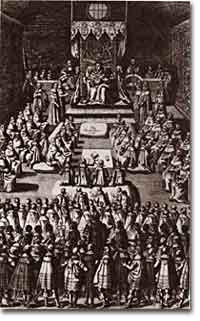
Britain has had a representative democracy since the seventeenth century. Members of the British Parliament are elected from across Britain and represent the interests of their constituents to the government.
Democracies have come in many shapes and sizes, as reflected by the different answers to questions of how, when, and to which people power is given. And although it is not mentioned in the Declaration of Independence or the Constitution, democracy clearly links to “rule of law” to form a basic principle that profoundly shapes American government.
Democratic Values—Liberty, Equality, Justice
Liberty and equality.
These words represent basic values of democratic political systems, including that of the United States. Rule by absolute monarchs and emperors has often brought peace and order, but at the cost of personal freedoms. Democratic values support the belief that an orderly society can exist in which freedom is preserved. But order and freedom must be balanced.
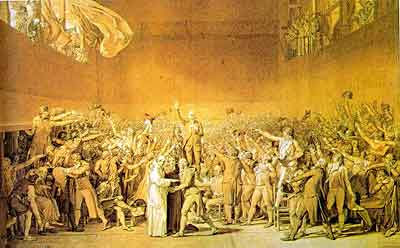
In the early days of the French revolution, the members of the third estate agreed to stick together in the face of opposition from the king and nobles. The “Tennis Court Oath” became the first step toward representative democracy in France.
The Influence of the Enlightenment
The American government has its roots in the seventeenth- and eighteenth-century Enlightenment in Europe, a movement that questioned the traditional authority of the monarch to rule. What gives one person the right to rule another? Enlightenment philosophers answered the question by acknowledging the importance of establishing order. They were influenced by the chaos of medieval times, when a lack of centralized government brought widespread death and destruction. Havens from invaders and attackers were necessary for survival, so weaker people allied themselves with stronger ones, and kings came to rule who provided protection in return for work and allegiance from their subjects.
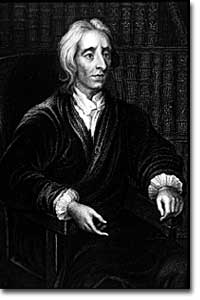
John Locke was the English philosopher who theorized that government was the manifestation of a general will of “the governed” that allowed the governed to change their governors at will. His book, Treatises on Civil Government, was very influential in the American revolution.
As order was established and new economic patterns emerged, people began to question the king’s right to rule. For example, John Locke, an eighteenth-century English philosopher, theorized that the right to rule came from the “consent of the governed.” Montesquieu wrote with admiration about three “branches” of government that checked one another’s power. Rousseau believed that communities were most justly governed by the “general will” or majority rule of their citizens. Though the philosophers believed that rulers were important for maintaining order, they questioned the sacrifice of individual freedom that they saw under European monarchs.
Two Kinds of Balance
Imagine a society in which everyone was perfectly free to do as he or she pleased. How long would it take for chaos to set in? Order implies a necessary loss of freedom if people are to survive. However, how far can order go? Democratic countries cherish INDIVIDUAL FREEDOM and generally believe that laws should not be REPRESSIVE; a little order can be sacrificed in the name of LIBERTY. So one kind of balance is between order and liberty.
Democratic societies also expect another kind of balance: a compromise between liberty and equality. Complete liberty logically leads to inequality. A strong or ambitious person might acquire more goods and property than another, and someone is bound to dominate. But the line has to be drawn before an individual seizes power that greatly restricts the liberties of others.
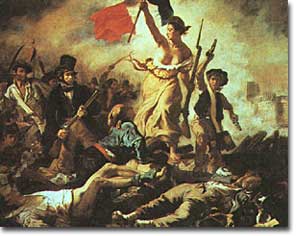
The ideals of the first French revolution also inspired the 1830 revolution in Paris. The ideas of “Liberty, Equality, and Fraternity” were immortalized in the three colors of the French flag. In Delacroix’s painting, Liberty is seen leading the people toward these ideals.
Shouldn’t governments help preserve some degree of equality for their citizens? But if they overemphasize equality, won’t they restrict their citizens’ liberty? For example, governments can bring about more equality by taxing rich citizens more than the poor, but if they carry their policies too far, won’t they restrict the individual’s freedom to strive for economic success? The balance between liberty and equality is an important cornerstone of democratic government.
In the late eighteenth century the Founders created the blueprints for the United States government in an effort to achieve these delicate balances—between liberty and order, and between liberty and equality. Their success is reflected in the continuing efforts to refine them. The formula has changed with time, but the framework provided by the Constitution and the values expressed by the Declaration of Independence remain the same.
Candela Citations
- The Nature of Government. Provided by: Independence Hall Association. Located at: http://www.ushistory.org/gov/1c.asp. License: CC BY: Attribution
- Matthew Mendelsohn and Andrew Parkin, eds., Referendum Democracy: Citizens, Elites and Deliberation in Referendum Campaigns (New York: Palgrave, 2001). ↵
- Pamela M. Prah, “Guide to State Ballot Measures for 2010,” Stateline.org, November 12, 2010. ↵
- For its history and an evaluation of the arguments for and against the initiative, see Joseph F. Zimmerman, The Initiative: Citizen Law-Making (Westport, CT: Praeger, 1999). ↵
- For criticisms of the initiative see Richard J. Ellis, Democratic Delusions: The Initiative Process in America (Lawrence: University Press of Kansas, 2002). ↵
- John G. Matsusaka, For the Many or the Few (Chicago: University of Chicago Press, 2004), xi. ↵
